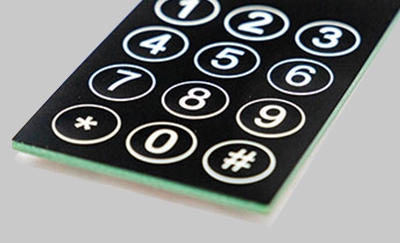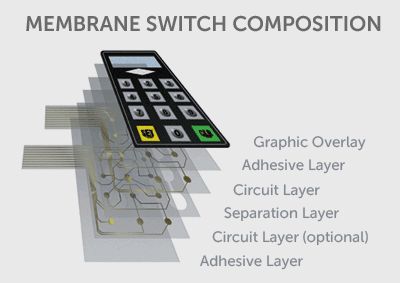Understanding Membrane Switches: The Key to Durable and Dependable Controls
Membrane layer switches over represent a vital aspect of modern-day user interface layout, blending functionality with resilience in various applications. These functional components not only facilitate individual communication however are also crafted to withstand the roughness of requiring settings, from medical devices to commercial equipment. Understanding their construction, operation, and the myriad advantages they provide is necessary for designers and designers alike. As we explore the ins and outs of membrane buttons, it ends up being clear that their role in boosting control systems is both complex and extensive, raising inquiries regarding just how ideal to take advantage of their abilities in future technologies.
What Are Membrane Layer Buttons?
Membrane layer switches are an innovative remedy in the realm of customer interface technology, incorporating functionality and design perfectly. These tools function as an interface between users and electronic systems, integrating several components into a small style. Normally created from adaptable, slim layers of products, membrane layer switches are developed to react to touch, making it possible for customers to communicate with machinery and digital gadgets successfully.
The main components of a membrane switch consist of a printed circuit layer, visuals overlay, and a spacer layer that stops unexpected activation. The graphic overlay can be customized to mirror brand identification or customer preferences, enhancing looks while guaranteeing usability. Membrane switches are frequently utilized in various applications, including medical devices, customer electronics, and industrial equipment, owing to their durability and resistance to ecological factors such as wetness and dust.
One of the vital benefits of membrane layer switches is their ability to withstand deterioration, making them ideal for high-traffic settings. Additionally, they are light-weight and require marginal area, permitting ingenious layouts in item development. On the whole, membrane switches over represent a effective and practical selection for contemporary electronic user interfaces, marrying modern technology with user-centric style concepts.

How Membrane Layer Switches Over Work
The procedure of membrane layer changes depend upon a basic yet efficient system that translates customer input right into electronic signals. These buttons include multiple layers, generally consisting of a graphic overlay, a spacer layer, and a circuit layer. When a user presses the button, the leading layer warps, allowing a conductive aspect in the circuit layer to make call with a matching conductive pad on the bottom of the visuals overlay. This call closes the circuit and sends an electronic signal to the device, showing that the switch has been activated.
The style of membrane buttons can differ, however they frequently incorporate domes or tactile aspects to provide feedback to the user, improving the overall experience. The products utilized in membrane layer switches, such as polyester or polycarbonate, add to their durability and resistance to environmental factors, consisting of wetness and dirt. The published circuits are commonly encapsulated, which secures them from wear and tear over time.

Advantages of Membrane Layer Buttons
Among the primary advantages of membrane buttons is their adaptability in style, enabling them to be customized to fulfill particular user needs and visual requirements. This flexibility reaches different sectors, where various forms, sizes, and colors can be employed to boost user interaction and visual allure.
Additionally, membrane switches are understood for their sturdiness. Built from robust products, they are immune to dust, moisture, and physical wear, which substantially extends their life-span contrasted to typical mechanical switches. This longevity makes them specifically suitable for high-traffic atmospheres and applications needing longevity.

Furthermore, membrane layer switches use a structured profile, causing a thinner layout that can be integrated right into various gadgets without adding bulk. This function not just enhances the aesthetic appeal however additionally adds to an extra ergonomic item design.

Applications of Membrane Layer Buttons
Straightforward and functional, membrane layer buttons find applications throughout a web vast array of industries, consisting of clinical tools, customer electronics, and industrial equipment. In the medical field, these buttons are indispensable to tools such as analysis why not try these out equipment, individual monitoring systems, and infusion pumps, where dependability and convenience of cleansing are vital. Their capacity to withstand harsh settings and maintain functionality makes them perfect for such applications.
In customer electronics, membrane switches are made use of in items like microwaves, cleaning machines, and remote controls - membrane switch. Their smooth style permits intuitive user interfaces, enhancing the total customer experience while supplying durability and resistance to tear and use
Industrial devices also benefits from membrane layer switches, especially in control panels for machinery and automation systems. These buttons provide protection against dust and wetness, making sure constant performance in difficult settings. Their adjustable attributes enable manufacturers to customize them to certain functional requirements, enhancing effectiveness and performance.
Picking the Right Membrane Layer Switch
When picking a membrane layer button, it is necessary to take into consideration different aspects that influence performance and viability for certain applications. The key considerations include ecological conditions, tactile comments, durability, and style requirements.
First, evaluate the operating environment; switches revealed to moisture, chemicals, or severe temperatures need certain products to make sure long life and functionality. Next off, review the requirement for responsive feedback. Depending upon customer communication, some applications may gain from a tactile action to validate activation, while others may choose a non-tactile layout for aesthetic reasons.
Toughness is one more crucial aspect; membrane layer buttons must be designed to endure regular usage, impacts, and abrasion. Make certain the selected switch can endure the anticipated lifecycle, especially in high-usage situations.
Final Thought
In verdict, membrane layer changes act as necessary elements in the style of sturdy and dependable control systems throughout numerous sectors. Their portable layout, combined with durable building and adjustable functions, enhances customer communication while making sure durability in demanding settings. The adaptability of membrane switches permits tailored solutions that fulfill certain functional requirements, reinforcing their significance in modern technology. membrane switch. As industries remain my website to progress, the significance of incorporating efficient membrane button options can not be overemphasized.
Membrane changes stand for a crucial facet of contemporary interface style, blending capability with durability in various applications.Membrane layer switches are an advanced service in the world of user interface innovation, integrating performance and layout effortlessly. Typically created from adaptable, slim layers of materials, membrane layer buttons are made to react to touch, making it possible for users to engage with machinery and electronic gadgets successfully.
The layout of membrane switches can vary, however they usually include domes or responsive elements to offer comments to the customer, improving the general experience.In verdict, membrane layer changes offer as important elements in the style of reputable and long lasting control systems throughout various sectors.